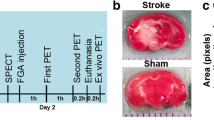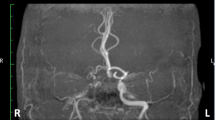Abstract
Phospholipid metabolism is closely related to membrane perturbation in cerebral ischaemia. We investigated in vivo topographical lipid metabolism using an iodine-123-labelled diacylglycerol analogue, (1-(15-(4-iodine-123-iodophenyl)-pentadecanoyl)-2-stearoyl-rac-glycerol) (123I-labelled DAG), in a middle cerebral artery (MCA) occlusion model with the aim of positive imaging of ischaemic insult. Sprague-Dawley rats underwent coagulation of the MCA to induce permanent occlusion. MCA occlusion times prior to injection of123I-labelled DAG ranged from 15 min to 14 days. Each rat was injected with 11–37 MBq of123I-labelled DAG via a tail vein. After 30 min, in vivo autoradiographs were reconstructed. Scanning of the living rat brain in this MCA occlusion model was performed using a gamma camera with a pinhole collimator. Cerebral infarctions were recognized in the frontal cortex, the parietal cortex and the lateral portion of the caudate-putamen by 2,3,5-triphenyltetrazolium hydrochloride staining. In infarcted regions (region 1),123I-labelled DAG incorporation showed a slight decrease up to 12 h; it then increased up to 6 days and decreased thereafter. In peri-infarcted regions (region 2), the incorporation showed almost no change up to 12 h, then increased up to 5–6 days and decreased thereafter. In other regions (region 3), the incorporation showed no change. Lipid analysis showed that123I-labelled DAG was metabolized to 15-(4-iodine-123-iodophenyl)-pentadecanoic acid by DAG lipase and to123I-labelled phosphatidylcholine. Scanning of the ischaemic region showed higher accumulation than on the non-lesioned side. We established a method to visualize ischaemic foci as positive images. The early changes in123I-labelled DAG incorporation were closely related to DAG lipase, which degraded the accumulated intrinsic DAG, and increased123I-labelled DAG incorporation in the chronic stage involves several aspects of neural destruction in the process of autolysis. It is concluded that the reported method could have a clinical future.
Similar content being viewed by others
References
Berridge MJ. Inositol triphosphate and diacylglycerol as second messengers.Biochem J 1984; 220: 345–360.
Nishizuka Y. The role of protein kinase C in cell surface signal transduction and tumour promotion.Nature 1984; 308: 693–698.
Abe K, Kogure K, Yamamoto H, Imazawa M, Miyamoto K. Mechanism of arachidonic acid liberation during ischemia in gerbil cerebral cortex.J Neurochem 1987; 48: 503–509.
Ikeda M, Yoshida S, Busto R, Santiso M, Ginsberg MD. Polyphosphoinositides as a probable source of brain free fatty acids accumulated at the onset of ischemia.J Neurochem 1986; 47: 123–132.
Shears SB. Regulation of the metabolism of 1,2-diacylglycerols and inositol phosphates that respond to receptor activation.Pharmacol Ther 1991; 49: 79–104.
Welsh CJ, Cabot MC.sn-1,2-Diacylglycerols and phorbol diesters: uptake, metabolism, and subsequent assimilation of the diacylglycerol metabolites into complex lipids of cultured cells.J Cell Biochem 1987; 35: 231–245.
Strawn LM, Martell RE, Simpson RU, Leach KL, Counsell RE. Synthesis and evaluation of iodinated analogues of diacylglycerols as potential probes for protein kinase C.J Med Chem 1989; 32: 643–648.
Strawn LM, Martell RE, Simpson RU, Leach KL, Counsell RE. Iodoaryl analogues of dioctanoylglycerol and 1-oleyl-2-acetylglycerol as probes for protein kinase C.J Med Chem 1989; 32: 2104–2110.
Imahori Y, Fujii R, Ueda S, et al. No-carrier-added carbon-11-labeledsn-1,2- andsn-1,3-diacylglycerols by [11C]propyl ketene method.J Nucl Med 1991;32: 1622–1626.
Imahori Y, Fujii R, Ueda S, et al. Membrane trapping of carbon-11-labeled 1,2-diacylglycerols as a basic concept for assessing phosphatidylinositol turnover in neurotransmission process.J Nucl Med 1992; 33: 413–422.
Imahori Y, Fujii R, Ueda S, et al. Phosphoinositide turnover imaging linked to muscarinic cholinergic receptor in the central nervous system by positron emission tomography.J Nucl Med 1993; 34: 1543–1551.
Machulla HJ, Marsmann M, Dutschka K. Synthesis of radioiodinated phenylfatty acids for studying myocardial metabolism.J Radioanal Chem 1980; 56: 253–261.
Machulla HJ, Marsmann M, Dutschka K. Biochemical concept and synthesis of a radioiodinated phenylfatty acid for in vivo metabolic studies of the myocardium.Eur J Nucl Med 1980; 5: 171–173.
Kulkarni PV, Parkey RW. A new radioiodination method utilizing organothallium intermediate: radioiodination of phenyl pentadecanoic acid (PPA) for potential applications in myocardial imaging.J Nucl Med 1982; 23: p105.
Hnatowich DJ, Layne WW, Childs RL. The preparation and labeling of DTPA-coupled albumin.Int J Appl Radiat Isot 1982; 33: 327–332.
Shirakami Y, Matsumoto Y, Yamauchi Y, et al. Development of Tc-99m-DTPA-HSA as a new blood pool scanning agent.Jpn J Nucl Med 1987; 24: 475–477.
Tamura A, Graham DI, McCulloch J, Teasdale GM. Focal cerebral ischaemia in the rat: 1. Description of technique and early neuropathological consequences following middle cerebral artery occlusion.J Cereb Blood Flow Metab 1981; 1: 53–60.
Tamura A, Graham DI, McCulloch J, Teasdale GM. Focal cerebral ischaemia in the rat: 2. Regional cerebral blood flow determined by [14C]iodoantipirine autoradiography following middle cerebral artery occlusion.J Cereb Blood Flow Metab 1981; 1: 61–69.
Gotoh O, Asano T, Koide T, Takakura K. Ischemic brain edema following occlusion of the middle cerebral artery in the rat. 1: The time courses of the brain water, sodium and potassium contents and blood-brain barrier permeability to125I-albumin.Stroke 1985; 16: 101–109.
Paxinos G, Watson C. The rat brain in stereotaxic coordinates, 2nd edn. San Diego: Academic Press, 1986.
Bederson JB, Pitts LH, Germano SM, Nishimura MC, Davis RL, Bartkowski HM. Evaluation of 2,3,5-triphenyltetrazolium chloride as a stain for detection and quantification of experimental cerebral infarction in rats.Stroke 1986; 17: 1304–1308.
Weber DA, Ivanovic M, Franceschi D, et al. Pinhole SPECT: an approach to in vivo high resolution SPECT imaging in small laboratory animals.J Nucl Med 1994;35: 342–348.
Bishop WR, Bell RM. Attenuation of sn-1,2-diacylglycerol second messengers.J Biol Chem 1986; 261: 12513–12519.
Kanoh H, Yamada K, Sakane F. Diacylglycerol kinase: a key modulator of signal transduction?Trends Biochem Sci 1990; 15: 47–50.
Ohmori Y, Imahori Y, Ueda S, et al. Protein kinase C imaging using carbon-l1-labeled phorbol esters: 12-deoxyphorbol 13isobutyrate-20-[1-11C]butyrate as the potential ligand for positron emission tomography.J Nucl Med 1993; 34: 431–439.
Horrocks LA, Dorman RV, Dabrowiecki Z, Goracci G, Porcellati G. CDPcholine and CD-Pethanolamine prevent the release of free fatty acids during brain ischemia.Prog Lipid Res 1982; 20:531–534.
Allan D, Michell RH. Accumulation of 1,2-diacylglycerol in the plasma membrane may lead to echinocyte transformation of erythrocytes.Nature 1975; 258: 348–349.
Pagano RE, Longmuir KJ. Phosphorylation, transbilayer movement, and facilitated intracellular transport of diacylglycerol are involved in the uptake of a fluorescent analog of phosphatidic acid by cultured fibroblasts.J Biol Chem 1985; 260: 1909–1916.
Allan D, Thomas P, Michell RH. Rapid transbilayer diffusion of 1,2-diacylglycerol and its relevance to control of membrane curvature.Nature 1978; 276: 289–290.
Farooqui AA, Rammohan KW, Horrocks LA. Isolation, characterization, and regulation of diacylglycerol lipases from the bovine brain. Ann N Y Acad Sci 1989; 559: 25–36.
Farooqui AA, Taylor WA, Horrocks LA. Phospholipases, lysophospholipases, and lipases and their involvement in various diseases.Neurochem Pathol 1987: 7: 99–128.
Edgar AD, Strosznajder J, Horrocks LA. Activation of ethanolamine phospholipase AZ in brain during ischemia.J Neurochem 1982; 39: 1111–1116.
Goracci G, Francescangeli E, Horrocks LA, Porcellati G. The reverse reaction of cholinephosphotransferase in rat brain microsomes: a new pathway for degradation of phosphatidylcholine. Biochim Biophys Acta 1981; 664: 373–379.
Duverger D, MacKenzie ET. The quantification of cerebral infarction following focal ischemia in the rat: influence of strain, arterial pressure, blood glucose concentration, and age.J Cereb Blood Flow Metab 1988; 8: 449–461.
Author information
Authors and Affiliations
Rights and permissions
About this article
Cite this article
Ohmori, Y., Imahori, Y., Ueda, S. et al. Radioiodinated diacylglycerol analogue: a potential imaging agent for single-photon emission tomographic investigations of cerebral ischaemia. Eur J Nucl Med 23, 280–289 (1996). https://doi.org/10.1007/BF00837626
Received:
Revised:
Issue Date:
DOI: https://doi.org/10.1007/BF00837626




